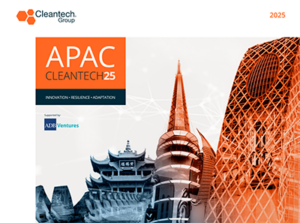Postcard Perspectives from the Asia-Pacific Region | China & India | Part I
The world is much bigger than just the U.S. and Trump’s “America First” agenda. Our first quarterly bulletin from the Asia-Pacific region in 2025 is focused on providing you with some perspectives on the year ahead from cleantech players across Asia. They see the world differently.
We have contributions this quarter from China and India, as well as from a number of Singapore-based investors, whose interests and perspectives are pan-regional.
Part I focuses on China and India, and Part II is where you’ll see those perspectives from Southeast Asia.
Our guest contributors were reacting to the open questions:
What kind of year do you expect in 2025 for cleantech, from your perspective, from where you are in the world? What trends/topics are you particularly paying attention to, and why?

“As we enter 2025, China’s support for cleantech innovators is expected to continue growing.
With the U.S.-China tech rivalry persisting and the nation undergoing preparations for its 15th Five Year Plan (2026-2030), policies supporting China’s green transformation and high-tech innovation will remain as top priorities. Among which, here are three sectors we will have under the microscope this year:
- Green Hydrogen: In 2022, the Chinese government released the Medium- and Long-Term Plan for the Development of Hydrogen Energy Industry (2021-2035), establishing hydrogen as a strategic industry essential to China’s carbon neutrality goal. Targets were also set to achieve domestic green hydrogen production of 100,000-200,000 tons by 2025. To achieve this goal, the country aims to make significant progress this year in developing hydrogen metallurgy equipment and key materials/components, production technologies for green methanol and synthetic ammonia, and constructing green methanol/ammonia demonstration projects. We are optimistic about China’s progress in this sector.
_ - Synthetic Biology: In recent years, China is emerging as an indispensable player in the SynBio market with remarkable progress. Currently, the country has the world’s leading bio-manufacturing infrastructure with capabilities to scale up production rapidly and cost-effectively, thereby laying a strong foundation for industrializing SynBio technology. Specifically, we are homing in on cleantech opportunities for SynBio substitutions for high-value animal-derived products.
_ - Artificial Intelligence: Evident from recent global recognition for DeepSeek R1, China’s AI ecosystem is maintaining momentum despite U.S. chip sanctions. CICC (China International Capital Corporation) estimations also indicate China’s AI market demand will reach $1.4T by 2030. Hence, from a cleantech perspective, we will be zooming in on start-ups that can optimize existing AI infrastructure for better energy efficiency, as well as emerging AI technologies with emission-reduction capabilities in the mobility and robotic manufacturing sectors.”
Cleantech Group Take
Interesting to note the green hydrogen comment. In the west, green hydrogen has been riding the hype curve and is somewhere in or around the trough of disillusionment right now (as per Gartner’s Hype Cycle) – one, because of doubts of how much of the green premium can be reduced, and two, doubts about where sizeable future demand will come from, to allow for economies of scale to be achieved.

“From my perspective in China, I’m focusing on how Chinese companies collaborate with governments and businesses worldwide.
China’s experience in renewable energy and its manufacturing capabilities are key assets for international markets.
Chinese firms in solar, wind, and electric vehicles are positioning themselves as global leaders, leveraging strategic partnerships to navigate local markets and regulations.
I’m particularly interested in how these cross-border collaborations foster mutual benefits, with China exporting both products and expertise while contributing to global clean energy goals.”
Cleantech Group Take
Winston Churchill once quipped that, “The United States can always be relied upon to do the right thing — having first exhausted all possible alternatives.” As the U.S. federal government, distinct from its innovation ecosystem, is fully focused on other alternatives than gearing their industrial and technology future to a cleaner and climate-resilient future, despite all the benefits on offer – from jobs and local manufacturing, from national security to personal health – it will be fascinating to see how the rest of the world chooses to interact with China on the cross-border collaborations referenced above. We are expecting them to increase.

“In 2025, climate tech is expected to focus on scaling proven solutions rather than radical breakthroughs.
Here are some key trends shaping the sector.
- Industrial decarbonization in hard-to-abate sectors like cement and steel will gain traction, supported by regulatory pressure and corporate commitments, with companies like Carbon Clean advancing carbon capture for industrial applications.
_ - Companies like Ecofy in climate financing will evolve, with models like blended finance and carbon markets helping unlock capital, particularly in emerging markets.
_ - Localized solutions for energy, cooling, and water resilience will be crucial, especially in regions like India, where companies like Smart Joules are optimizing energy efficiency.
_ - Bio-based materials and regenerative agriculture will see increased adoption, driven by sustainability goals and supply chain shifts, with companies like Prescinto leveraging AI-driven analytics to enhance the efficiency of clean energy assets.
_ - AI will play a growing role in climate solutions, though its energy demands raise concerns. The biggest challenge remains transitioning from pilots to large-scale deployment, ensuring these innovations move beyond early adopters to widespread impact, as seen with Solar Square, which is accelerating residential solar adoption in India.”
Cleantech Group Take
Scaling proven solutions for the rest of the 2020’s is everything. Not only is this needed to get as close as we can from here to the decarbonization path laid out in Paris in 2015 and re-mapped by the IEA in their Net Zero Emissions by 2050 Scenario work, but doing so will also provide a major demand boost to a never-ending innovation wave beyond to keep improving and optimizing as clean technologies mainstream.



